Aras (river)
The Aras or Araxes is a river that starts in Turkey and then flows along the borders between Turkey and Armenia, between Turkey and the Nakhchivan area of Azerbaijan, between Iran and both Azerbaijan and Armenia, and finally through Azerbaijan to the Kura River. It drains the south side of the Lesser Caucasus Mountains and then joins the Kura, which drains the north side of Lesser Caucasus Mountains. Its total length is 1,072 kilometres (666 mi), covering an area of 102,000 square kilometres (39,000 sq mi). The Aras River is one of the largest rivers in the Caucasus.
| Aras | |
|---|---|
 | |
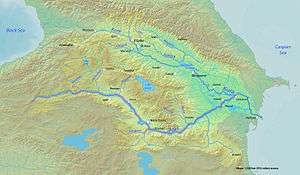 Aras River highlighted on a map of the Kura River watershed | |
| Location | |
| Country | Turkey, Armenia, Iran, Azerbaijan |
| Physical characteristics | |
| Source | |
| • location | Erzurum Province, Turkey |
| Mouth | |
• location | Kura river in Sabirabad (city) |
| Length | 1,072 km (666 mi) |
| Basin size | 102,000 km2 (39,000 sq mi) |
| Discharge | |
| • average | 285 m3/s (10,100 cu ft/s) |
Names
In the classical antiquity, the river was known to the Greeks as Araxes (Greek: Ἀράξης). Its modern Armenian name is Arax or Araks (Armenian: Արաքս). Historically it was also known as Yeraskh (Old Armenian: Երասխ), and its Old Georgian name is Rakhsi (რახსი). In Azerbaijani, the river name is Araz. In Persian and Kurdish its name is ارس (Aras) and in Turkish it is Aras.
Description
The Aras rises near Erzurum in Turkey and meets with the Akhurian River southeast of Digor. From Digor it flows along the Armenia–Turkey border, and then runs close to the corridor that connects Turkey to Azerbaijan's Nakhchivan exclave. It then continues along the Iranian-Armenian and the Iranian-Azerbaijan border.[1]
The Zangmar, Sariso, Ghotour River, Hajilar River, Kalibar River, Ilghena River, Darreh River and Balha River are the major tributaries of the Aras from the South. In Turkey, the Ghareso river flows in from the North, and the Akhurian, Metsamor, Hrazdan, Azat, Vedi, Arpa, Vorotan, Voghdji and Meghri rivers join in from the Armenian (North) side. The Khachin River, Okhchi River, Kuri River and Kandlan River flow into the river from the Azerbaijan (North) side.[2]
Etymology and history
In Armenian tradition, the river is named after Arast, a great-grandson of the legendary Armenian patriarch Haik.[3] The name was later Hellenized to Araxes and was applied to the Kura-Araxes culture, a prehistoric people who flourished in the valleys of the Kura and Aras. The river is also mentioned in the last chapter of the Aeneid VIII by Virgil, as "angry at the bridge," since the Romans built a bridge over it, so that it is thereby conquered. The river Aras has been associated with the biblical rivers Gihon and Pishon.[4] Robert H. Hewsen described Aras as the only "true river" of Armenia and as "Mother Araxes," a symbol of pride to the Armenian people.[5]
According to a legend cited by Strabo in ancient times Araxes river in Armenia had no outflow to Caspian sea but spread out in plains and created a lake without outflow.[6]
In Islamic times, the Araxes became known in Arabic parlance as al-Rass (not to be confused with modern-day Ar Rass) and in Perso-Turkish contexts as Aras.[1]
In modern history, the Aras gained significance as a geographic political boundary. Under the terms of the Treaty of Gulistan and the Treaty of Turkmenchay, the river was chosen as the border limit between the Russian Empire and Qajar Iran, as the latter was forced to cede its Caucasian territories to Russia.[7]. Because of this 19 century border changes one modern not widely accepted scheme draws Aras River as the line of continental demarcation between Europe and Asia [8].
Iran and the Soviet Union has in 20 century built the Aras Dam on the Aras in the Poldasht area creating the Aras Reservoir. The Meghri Dam is under construction near the Armenian town of Meghri.[9]
Aras Valley
In 2006, a bird research and education center was established by KuzeyDoğa, a Turkish non-governmental organization for nature conservation, in the Aras Valley at the village Yukarı Çıyrıklı, in the Tuzluca district of Iğdır Province, Turkey. It is one of Turkey's two bird ringing stations that remain active yearly.[10] Between 2006 and 2015, more than 65,000 birds of 198 species were ringed and 258 bird species were observed at this station. Fifty-five percent of the 471 bird species found in Turkey are recorded at this wetland, making it Turkey's most important wetland for birds. The number of ringed and observed 258 bird species comprises 85 percent of the 303 bird species in Iğdır Province. Seven new bird species were observed during the bird ringing activities in 2012 alone, including the raptor Shikra or Little Banded Goshawk (Accipiter badius), which was new to Turkey's avifauna.[11][12]
University of Utah biology professor Çağan Şekercioğlu, president of the KuzeyDoğa Society, appealed to the Ministry of Forest and Water Management to drop the Tuzluca Dam project, which would destroy the wetland harboring bird wildlife in the Aras Valley.[11][13] In 2013, the ministry granted the site the highest level of conservation status (Nature Conservation Area).
Gallery
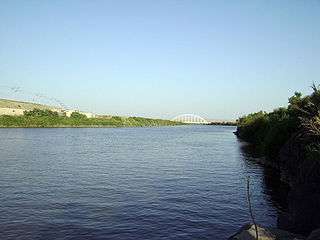 The Aras taken in the Poldasht District.
The Aras taken in the Poldasht District.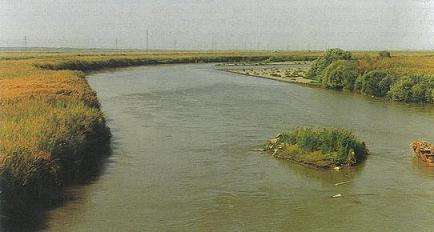 The Aras, taken from Iğdır.
The Aras, taken from Iğdır.- Photograph of the Aras from space.
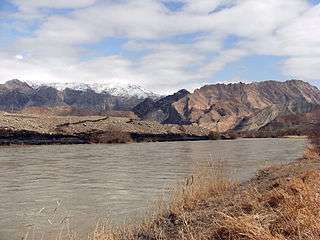 The Araz near Joulfa.
The Araz near Joulfa..jpg) Aras River with Iran to the left and Republic of Artsakh (Nagorno Karabakh) / Azerbaijan to the right.
Aras River with Iran to the left and Republic of Artsakh (Nagorno Karabakh) / Azerbaijan to the right.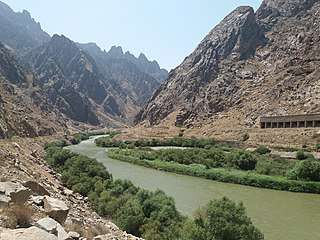
See also
| Wikimedia Commons has media related to Aras River. |
- Armenia–Iran border
- Azerbaijan–Iran border
- Geography of Armenia
- Geography of Azerbaijan
- Geography of Iran
- Geography of Turkey
- Nature of Azerbaijan
- Rivers and lakes in Armenia
- Rivers and lakes in Azerbaijan
Footnotes
- "Araxes River". Encyclopædia Iranica. Retrieved 3 May 2018.
- "Environmental Performance Reviews - Armenia" (PDF). New York and Geneva: United Nations Economic Commission for Europe. 2000. ISBN 92-1-116775-2.
- Bauer-Manndorff, Elisabeth (1981). Armenia: Past and Present. Armenian Prelacy. p. 49. ASIN B0006EXQ9C.
- "Calumet, A. D. 1672–1757, Rosebmuller, 1768–1835, Kell, 1807–1888, and some other scholars believed the source river [for Eden] was a region of springs. The Pishon and Gihon were mountain streams. The former may have been the Phasis or Araxes, and the latter the Oxus." Duncan, George S. (October 1929) "The Birthplace of Man" The Scientific Monthly 29(4): pp. 359-362, p. 360
- Hewsen, Robert (1997). Hovannisian, Richard G. (ed.). The Armenian People From Ancient to Modern Times. Volume I: The Dynastic Periods: From Antiquity to the Fourteenth Century. New York: St. Martin's Press. p. 7. ISBN 0-312-10169-4.
- "Strabo, Geography, Book 11, chapter 14". www.perseus.tufts.edu. Retrieved 2018-01-15.
- "Russia at War: From the Mongol Conquest to Afghanistan, Chechnya, and Beyond ..." Retrieved 23 April 2015.
- Caucasus
- "News: Meghry Power Plant Kicks off". Iran Water & Power Resources Development Co. 17 November 2012. Archived from the original on 13 March 2016.
- Ocak, Serkan (28 July 2013). "Aras Kuş Cenneti müjdesi". Radikal (in Turkish). Retrieved 13 July 2014.
- "'Aras Kuş Cenneti korunmalı'". NTV MSNBC (in Turkish). 13 February 2013. Retrieved 13 July 2014.
- "Afrikalı atmaca Türkiye'de halkalandı". NTV MSNBC (in Turkish). 13 February 2013. Retrieved 13 July 2014.
- "Aras Nehri'ndeki Kuşlara ABD'den El Uzattı". Akdeniz Gazete (in Turkish). Archived from the original on 14 July 2014. Retrieved 13 July 2014. |